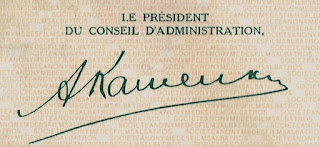Alexander Kamenka was born in 1888 in Odessa, Ukraine. Because of the Russian Revolution and the Russian Civil War he fled with film producer Joseph Ermolieff to France. In Montreuil near Paris, they established in 1920 a film production company.
In 1922 Ermolieff leaves Paris to continue his film work in Germany. Kamenka stays and founds a new company, the Société Anonyme des Films Albatros. Co-founders are Maurice Hache and Noë Bloch, the latter also being a refugee from Russia.
Société Anonyme des Films "Albatros"
Ordinary share of 100 Francs, 1924, printed by Imp. Richard
Several of Albatros' first films were directed by Victor Tourjansky : 1922 Nuit de carnaval, 1923 Calvaire d'amour, 1924 La Dame masquée. Tourjansky came from an artistic family in Kyiv. He had fled to Yalta, Crimea, during the Russian revolution. And after Lenin nationalized in 1919 the Soviet film industry he came to France with Ermolieff and his group of actors, cinematographers and directors.
The Albatros films were "silent" films. Films with recorded sound and dialogues were technically not possible to produce till the end of the 1920s. Silent-film actors emphasized body language and facial expression. Onscreen titles were used for explaining dialogues and actions. The title writer fulfilled a key function in addition to the scenario writer who created the story.
Alexander Kamenka (1888, Odessa - 1969, Paris) was the son of Boris Abramovich Kamenka (1855, Kiev - 1942). His father was an entrepreneur and banker in the Russian Empire. Boris Kamenka joined the board of several companies including the Azov-Don Bank and the Taganrog Metallurgical Company.
image : Cinémagazine 31 Dec 1926
Other Albatros movies from that period are La Maison du mystère, 1923, shot by, inter alia, cinematographer Fédote Bourgasoff (b. 1890, Lokhvitsia, Ukraine) and Kean, 1924, starring Ivan Mosjoukine and his wife Nathalie Lissenko. Born in Nikolayev, Ukraine, 1884, Lissenko left Russia in 1920 with her husband.
Other important film makers of the era working with Alexander Kamenka's Albatros Films included Jean Epstein, Jacques Feyder, Marcel L'Herbier and René Clair.
Alexander Kamenka produced in 1924 Le Lion des Mogols. The film directed by Jean Epstein and co-written by Ivan Mosjoukine was a success. Mosjoukine, the star of the Albatros studios, played the main role together with his wife Nathalie Lissenko. The actors fancy costumes and this movie poster were designed by Boris Bilinsky. He won a gold medal for that at the 1925 Paris International Exhibition of Decorative Arts. Bilinsky, a Russian Civil War refugee, was born in Bender, Moldova.
image : Multilingual Inventory of Cultural Heritage in Europe, films from the "Albatros" catalogue
At the end of the 1920s sound film made its entrance. Only well into the 1930s the Paris studios became fully sound-equipped. Many French sound movies were shot in Germany where film studios were faster to adopt the new technology.
It was a difficult time for Kamenka's Albatros company. Cagliostro, coproduced in 1929 with Wengeroff-Film and starring the German actor Hans Stüwe was still a silent movie. An interesting trivia is that Universal Pictures planned a remake of it with Boris Karloff in the title role, but the script was rewritten into The Mummy.
Facsimile signature of Alexander Kamenka, Managing and Artistic Director of Films "Albatros"
In 1930 Albatros produces Le procureur Hallers, a sound film. It was made in the same year in the same Berlin studio by director Robert Wiene as a French language version of Wiene's Der Andere. La porteuse de pain from 1934 stars actor Fernandel. Le Messager, a sound film from 1937 directed by Raymond Rouleau, was one of Albatros' last movie productions and featured French top actors Jean Gabin and Bernard Blier.
With the outbreak of World War II, Kamenka winds up the company. For the second time in his life, his home country, now France, goes through a war.
After WWII Alexander Kamenka organizes a new film production company, the Société des Films Alkam. He produces Les Frères Bouquinquant, 1948, Le mystère Barton, 1949, Coupable?, 1951, and several more movies. His son, Sacha Kamenka, born in 1910, will also become a movie producer.
The origin of the company name Films "Albatros" is not clear. Some sources refer to the the name of a boat which brought some of the fugitives from Russia. Besides adopting the image of the albatros as its symbol, the company took the motto "Debout dans la tempête" : Upright in the storm.
F.L.
Related links
Previous posts





No comments:
Post a Comment